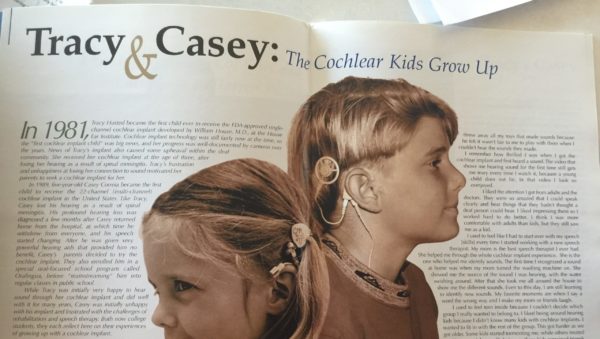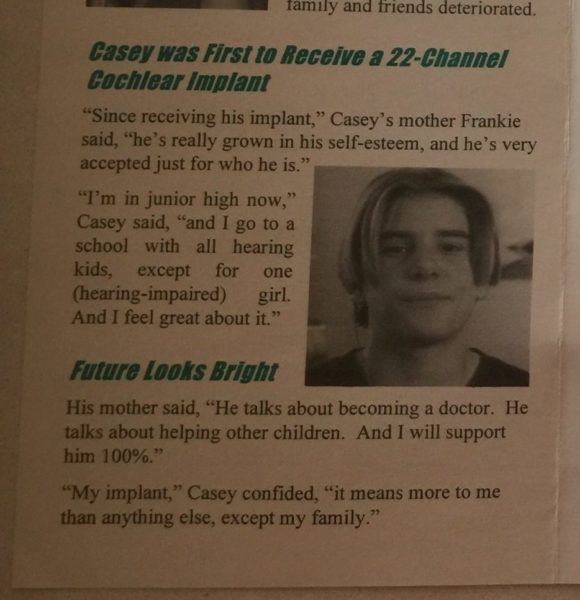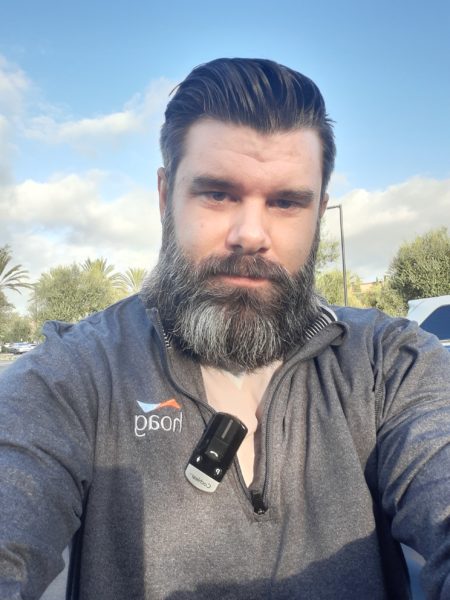At age 5, Casey contracted meningitis. When he woke up in the hospital, his parents realized he couldn't hear. After surviving a health scare, they now had to help their child navigate a world without hearing. A year later, they made the decision for Casey to become one of the first children to receive a cochlear implant in 1987, making cochlear implant history. Now 40, Casey is writing a book about his experience to help others.
My frustrating year without hearing
 “There was a year after I lost my hearing before I got the cochlear implant. I found that time challenging and frustrating. I didn’t know sign language and had no way to communicate. My voice deteriorated so much that my parents hardly understood me. All these factors led me to become depressed. Not being understood caused anger and frustration, and I would often lash out at my parents and siblings in fits of rage.
“There was a year after I lost my hearing before I got the cochlear implant. I found that time challenging and frustrating. I didn’t know sign language and had no way to communicate. My voice deteriorated so much that my parents hardly understood me. All these factors led me to become depressed. Not being understood caused anger and frustration, and I would often lash out at my parents and siblings in fits of rage.
I was sent to a school for the deaf, but not knowing how to lip read or sign made it difficult. I couldn’t communicate or socialize.
How my parents decided to get my historic cochlear implant
I would always ask my parents to please make me hear again. Hearing aids didn’t work and only led to further disappointment. I would have tried anything.
My parents learned about cochlear implants through an audiologist at our clinic. Naturally, they wanted what was best for me, seeing how depressed I was. It wasn’t an easy choice, considering I would be the first child in North America to receive the CochlearTM Nucleus® 22 implant. They made the decision after meeting and listening to the hearing health professionals at my clinic.
Getting a cochlear implant back then wasn’t without trial and tribulation – it was difficult at first, but in the end, it was the best decision my parents ever made for me.
Being ‘the first’ at something isn’t always easy
 I remember getting my cochlear implant activated. I found it loud and noisy and immediately wanted to take it off. As the first child with this implant, it wasn’t expected to be perfect at first. After a lot of mapping and tests, they perfected it for me and I’ve loved it ever since.
I remember getting my cochlear implant activated. I found it loud and noisy and immediately wanted to take it off. As the first child with this implant, it wasn’t expected to be perfect at first. After a lot of mapping and tests, they perfected it for me and I’ve loved it ever since.
I attended a school for the deaf for several years to learn hearing skills and speech before going mainstream in third grade. That was challenging as I wanted to fit in with other students and be seen as a ’normal‘ child. However, over time it became easier.
The other challenge I faced was figuring out the best way to make school work for me. Teachers often forgot I was deaf because I was well-spoken. They would talk while writing on the chalkboard, or people around me would talk, making it difficult to understand the teacher. I had to learn to find my voice, speak up and ask other classmates what I’d missed.
My life since then
 The cochlear implant has been nothing but a positive impact on my life. It took some getting used to, but being able to talk on the phone, listen to music, have conversations with friends and even go to a drive-thru have made all the difference. It does have some limitations, but where would I be now without being able to hear?
The cochlear implant has been nothing but a positive impact on my life. It took some getting used to, but being able to talk on the phone, listen to music, have conversations with friends and even go to a drive-thru have made all the difference. It does have some limitations, but where would I be now without being able to hear?
The technology has leapt ahead since 1987. For one, sound processors are a lot smaller! People don’t even notice them. The introduction of Bluetooth® compatibility1 has been a game-changer. I love streaming music and telephone calls. Wireless connectivity even blocks out any background noise, making phone calls even more accessible.
The programs also seem to get better in sound quality. I went from not enjoying music to now going to concerts. I can enjoy hearing and playing in the water with my children, which means a lot to me.
Discovering a fulfilling career
I decided to study nursing, but it wasn’t without its challenges. One day, I was doing rounds when one of my patients needed a chest X-ray. The technician came in with a portable X-ray machine. I thought it was very cool, so I started asking him questions. We talked all about it. That night I decided to quit the nursing program and enrolled into the radiology program the following year.
It was the best decision I have ever made. I am an X-ray technician, and I absolutely love my job. I don’t think it could have been possible without my cochlear implant, as it enables me to communicate with my patients without an interpreter and answer phones. Every day I talk over the phone with radiologists, patients and other health departments in my job.
Covid-19: Relying entirely on my cochlear implant
When everyone started wearing masks due to Covid-19, I had to rely fully on my cochlear implant, as I could no longer use lip-reading. I was nervous at first, but I’ve been doing really well and totally trust my hearing. Sure, there are times I don’t understand someone, but even hearing people have a hard time understanding people with masks.
I’m writing a book to try and help others
 I’m writing a book that’s mostly about my childhood, up to college. I want to share what it was like going deaf, getting the cochlear implant and all the experiences I’ve had (good and bad). Everyone knows at least one deaf person, whether they’re a family member, colleague, friend or acquaintance. I think this would benefit so many people: to understand us better and know how to help. People can’t comprehend what children and adults go through being deaf.
I’m writing a book that’s mostly about my childhood, up to college. I want to share what it was like going deaf, getting the cochlear implant and all the experiences I’ve had (good and bad). Everyone knows at least one deaf person, whether they’re a family member, colleague, friend or acquaintance. I think this would benefit so many people: to understand us better and know how to help. People can’t comprehend what children and adults go through being deaf.
This book offers another chance to give back to the community. I want to make sure some of the profits assist children who can’t afford to get a cochlear implant. I’m so blessed to be able to hear and want to share that with others.
If you’re trying to decide if you want a cochlear implant
My advice is: 100% absolutely do it! It could change your life. Why not? You can always choose not to wear it if you decide you don’t want to hear. You can have the best of both worlds, be a part of the hearing world and at the same time have peace and quiet when you want.”
Casey is part of cochlear implant history. If you experienced sudden hearing loss like him, learn about a solution that can help you today.
2- For complete smartphone compatibility information, please visit www.cochlear.com/compatibility.
- The Bluetooth® word mark and logos are registered trademarks owned by Bluetooth SIG, Inc. and any use of such marks by Cochlear is under license.